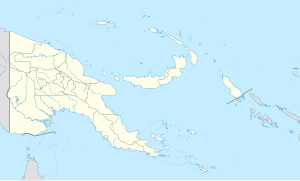Gurney Airport
| Gurney Airport | |||||||||||
|---|---|---|---|---|---|---|---|---|---|---|---|
| Summary | |||||||||||
| Airport type | Public | ||||||||||
| Operator | Government | ||||||||||
| Serves | Alotau, Milne Bay Province, Papua New Guinea | ||||||||||
| Elevation AMSL | 27 m / 89 ft | ||||||||||
| Coordinates | 10°18′41″S 150°20′01″E / 10.31139°S 150.33361°ECoordinates: 10°18′41″S 150°20′01″E / 10.31139°S 150.33361°E | ||||||||||
| Map | |||||||||||
| Location of the airport in Papua New Guinea | |||||||||||
| Runways | |||||||||||
|
|||||||||||
|
Source: WAD, GCM
|
|||||||||||
Gurney Airport (IATA: GUR, ICAO: AYGN) is an airport serving Alotau in the Milne Bay Province of Papua New Guinea.
The airport is a single runway general aviation facility, however in December, 2008, the PNG Minister for Transport and Civil Aviation, Don Polye announced that aviation company Skyworld had been granted permission to operate direct flights from Cairns, Australia to Gurney.
Built by the US Army 96th Engineer General Service Regiment, Company E of 46th Engineer General Service Regiment and No. 6 Mobile Works Squadron RAAF during World War II. Consisting of two parallel runways with the first runway 6,000 feet (1,800 m) long by 150 feet (46 m) wide surfaced with bitumen and the second runway 5,340 feet (1,630 m) long x 100 feet (30 m) wide surfaced with marston matting. Taxiways and revetments extended off both sides of the runways. Known as Fall River Aerodrome and No. 1 Strip. The airfield was named Gurney Field on 14 September 1942 in honour of Royal Australian Air Force Squadron Leader C.R. Gurney, who was killed in an aircraft crash.
The airfield was reopened in early 1966, as a part of the Australian colonial policy of having each of the provincial capitals served by daily flights. The last Sunbird PBY service to Samarai was in January of that year. A number of other WWII airfields were reopened in the area, such as Vivigani Airfield and Misima (April 1964). Several airlines then operated daily passenger and freight services into Gurney, using larger aircraft.
...
Wikipedia

